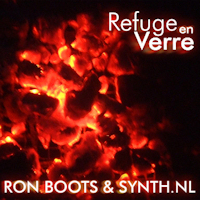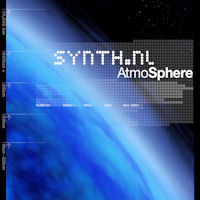
Last week we did a lot of cabling. I decided to make a series of postings on this as well since it will be quite some work ;) All cabling from the power cabinet upstairs to the server room are in place now. The most important for me was to get network downstairs so I could start moving and installing servers in the rack. Here you see the top part of the rack with two 19'' UTP patch panels on top. From the top panel 10 UTP cables go upstairs and the remaining 14 are going to my studio desk. This way I can easily patch stuff back and forth. You see different colors of patch cables. I do this to seperate different signals. I use blue for network, yellow for ISDN, white for PSTN and green for serial cabling. Below the patch panels you see a 24 port Cisco Gigabit switch and below that a power distributor that also has and Volt and Amp meter integrated. In total my rack uses 3 Ampere and the moment. Below that is an 8 port KVM switch and under that you see three NAS devices that each hold about a Terebyte of storage.

Here you can see the backside of this rack. As you can see the on the backside of the KVM switch two sets of keyboard and monitors can be attached. Through a key combination you can select any machines from the remote location. I will later on extend these console to the studio. For this reason we also put in a lot of UTP cabling because you an transport a lot of stuff like video, audio, USB, KVM over UTP and this makes it very flexible in this way. I already bought two KVM over UTP extenders that will take these consoles to my main studio desk later on. On of them also has a local remote switch so I can add another set of keyboard and monitor in the rack itself. Of course that is very convinient when I'm working in the server room.

All these cables run through the cabling guiding system that we installed before. I'm already very happy with it. A lot of cabling already is in there and there is still plenty of room for more :) Next to the blue UTP cabling you also see some gray cabling. These are power cables. One is coming from the server room and hold a separate power group for the studio and the other ones go back to all the power outlets that will be installed in the cable guiding system. In this way I can switch all these outlets separately from my main studio desk and also everything has one central earth to prevent ground loops. So basicly it is a star topology. We did the same for UTP. In the cabling guiding system are also 4 UTP outlets with every of the 5 power outlets in there. So in total 20 UTP outlets. When the studio desk is in place we will also put everything on 19" patch panels on that side.

The last thing I want to show you is the sub power cabinet that is also in the server room. This cabinet holds all the power groups for downstairs. There is a seperate group for all lights, the studio, the cinema, the 19" rack in the server room and also some extra airco groups. There is also some room to expand if necessary. From here a very big cable runs to the power cabinet upstairs. It will be more than sufficient for sure. The splitter you see left from the power cabinet is for cable TV and radio. So it is a passive CAI splitter. This way we can also watch TV and listen to radio downstairs. For the cinema I also put a Satellite cable downstairs to watch the HD channels on the Astra satellites later on :) And I'm planning to also watch the Formula 1 races next season down there :) OK enough for now. I will update you with more later
 Last week we did a lot of cabling. I decided to make a series of postings on this as well since it will be quite some work ;) All cabling from the power cabinet upstairs to the server room are in place now. The most important for me was to get network downstairs so I could start moving and installing servers in the rack. Here you see the top part of the rack with two 19'' UTP patch panels on top. From the top panel 10 UTP cables go upstairs and the remaining 14 are going to my studio desk. This way I can easily patch stuff back and forth. You see different colors of patch cables. I do this to seperate different signals. I use blue for network, yellow for ISDN, white for PSTN and green for serial cabling. Below the patch panels you see a 24 port Cisco Gigabit switch and below that a power distributor that also has and Volt and Amp meter integrated. In total my rack uses 3 Ampere and the moment. Below that is an 8 port KVM switch and under that you see three NAS devices that each hold about a Terebyte of storage.
Last week we did a lot of cabling. I decided to make a series of postings on this as well since it will be quite some work ;) All cabling from the power cabinet upstairs to the server room are in place now. The most important for me was to get network downstairs so I could start moving and installing servers in the rack. Here you see the top part of the rack with two 19'' UTP patch panels on top. From the top panel 10 UTP cables go upstairs and the remaining 14 are going to my studio desk. This way I can easily patch stuff back and forth. You see different colors of patch cables. I do this to seperate different signals. I use blue for network, yellow for ISDN, white for PSTN and green for serial cabling. Below the patch panels you see a 24 port Cisco Gigabit switch and below that a power distributor that also has and Volt and Amp meter integrated. In total my rack uses 3 Ampere and the moment. Below that is an 8 port KVM switch and under that you see three NAS devices that each hold about a Terebyte of storage. Here you can see the backside of this rack. As you can see the on the backside of the KVM switch two sets of keyboard and monitors can be attached. Through a key combination you can select any machines from the remote location. I will later on extend these console to the studio. For this reason we also put in a lot of UTP cabling because you an transport a lot of stuff like video, audio, USB, KVM over UTP and this makes it very flexible in this way. I already bought two KVM over UTP extenders that will take these consoles to my main studio desk later on. On of them also has a local remote switch so I can add another set of keyboard and monitor in the rack itself. Of course that is very convinient when I'm working in the server room.
Here you can see the backside of this rack. As you can see the on the backside of the KVM switch two sets of keyboard and monitors can be attached. Through a key combination you can select any machines from the remote location. I will later on extend these console to the studio. For this reason we also put in a lot of UTP cabling because you an transport a lot of stuff like video, audio, USB, KVM over UTP and this makes it very flexible in this way. I already bought two KVM over UTP extenders that will take these consoles to my main studio desk later on. On of them also has a local remote switch so I can add another set of keyboard and monitor in the rack itself. Of course that is very convinient when I'm working in the server room. All these cables run through the cabling guiding system that we installed before. I'm already very happy with it. A lot of cabling already is in there and there is still plenty of room for more :) Next to the blue UTP cabling you also see some gray cabling. These are power cables. One is coming from the server room and hold a separate power group for the studio and the other ones go back to all the power outlets that will be installed in the cable guiding system. In this way I can switch all these outlets separately from my main studio desk and also everything has one central earth to prevent ground loops. So basicly it is a star topology. We did the same for UTP. In the cabling guiding system are also 4 UTP outlets with every of the 5 power outlets in there. So in total 20 UTP outlets. When the studio desk is in place we will also put everything on 19" patch panels on that side.
All these cables run through the cabling guiding system that we installed before. I'm already very happy with it. A lot of cabling already is in there and there is still plenty of room for more :) Next to the blue UTP cabling you also see some gray cabling. These are power cables. One is coming from the server room and hold a separate power group for the studio and the other ones go back to all the power outlets that will be installed in the cable guiding system. In this way I can switch all these outlets separately from my main studio desk and also everything has one central earth to prevent ground loops. So basicly it is a star topology. We did the same for UTP. In the cabling guiding system are also 4 UTP outlets with every of the 5 power outlets in there. So in total 20 UTP outlets. When the studio desk is in place we will also put everything on 19" patch panels on that side. The last thing I want to show you is the sub power cabinet that is also in the server room. This cabinet holds all the power groups for downstairs. There is a seperate group for all lights, the studio, the cinema, the 19" rack in the server room and also some extra airco groups. There is also some room to expand if necessary. From here a very big cable runs to the power cabinet upstairs. It will be more than sufficient for sure. The splitter you see left from the power cabinet is for cable TV and radio. So it is a passive CAI splitter. This way we can also watch TV and listen to radio downstairs. For the cinema I also put a Satellite cable downstairs to watch the HD channels on the Astra satellites later on :) And I'm planning to also watch the Formula 1 races next season down there :) OK enough for now. I will update you with more later
The last thing I want to show you is the sub power cabinet that is also in the server room. This cabinet holds all the power groups for downstairs. There is a seperate group for all lights, the studio, the cinema, the 19" rack in the server room and also some extra airco groups. There is also some room to expand if necessary. From here a very big cable runs to the power cabinet upstairs. It will be more than sufficient for sure. The splitter you see left from the power cabinet is for cable TV and radio. So it is a passive CAI splitter. This way we can also watch TV and listen to radio downstairs. For the cinema I also put a Satellite cable downstairs to watch the HD channels on the Astra satellites later on :) And I'm planning to also watch the Formula 1 races next season down there :) OK enough for now. I will update you with more later










No comments:
Post a Comment